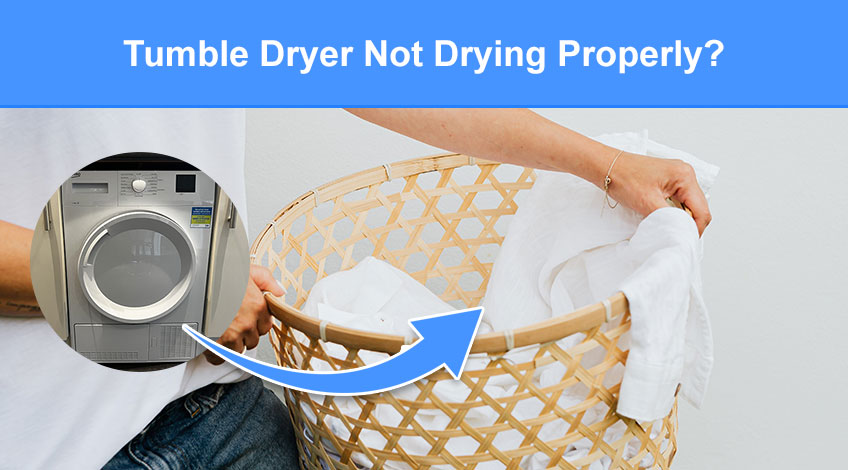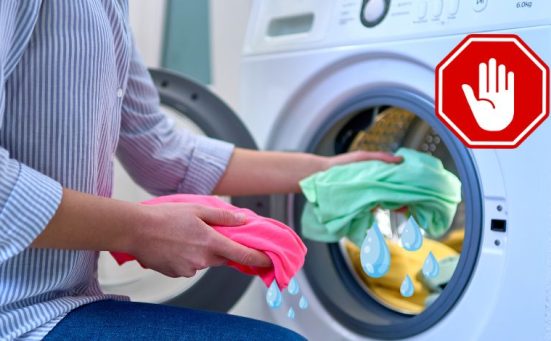
Tumble Dryer Not Drying Properly? (here’s why & how to fix)
It is quite normal for laundry to feel damp when it is still warm after the drying cycle finishes.
If, however, it still feels wet after it has had time to cool down, there are a few easy checks you can do to help solve this issue.
Why Is My Tumble Dryer Not Drying Properly?
Let’s start with the most common reasons for clothes to still be wet after the drying cycle has completed. These include;
Selecting An Incorrect Drying Cycle
If you select the wrong drying cycle for the particular items of clothes you wish to dry, they could still be damp or even wet once the cycle has finished.
You need to bear in mind that different materials require different settings to dry correctly. Consult your user manual for specific instructions.
You may need to adjust the drying time or the degree of dryness needed to dry certain items.
Full Or Clogged Lint Filter
If your laundry is taking far longer than usual to dry using the same drying program as usual, it could be that the lint filter is clogged.
Depending on the materials your clothes are made from, lint can build up very quickly. It’s a good idea to clean the lint filter after every use.
Vent Hose Clogged
On vented tumble dryers, the vent hose can become clogged which stops the moisture from escaping. To clear any blockage from a vent hose, remove the hose from the machine and inspect it for any lint or fluff that can build up in the hose.
To remove the lint blocking the hose we recommend using a dryer vent cleaning kit.
- 🌻🌻---Improving cloth dryer working performance by using this brush to cleaning the trapped lint and dust in dryer gap and exhaust port
- 🌻🌻---Flexible rod design, our cleaning brush rod is a flexible design that can be rotated to help you clean the inside of the washing machine, flexible operation, very practical
Water Reservoir Full
On condenser tumble dryers the moisture that is removed from the laundry is stored in a water tank. This water tank will need to be emptied regularly to ensure the dryer removes as much moisture as possible.
It is recommended that the water tank is emptied after every use.
Overloading The Drum
This is very easily done because in most cases, dryers do not have the drum capacity to dry as many clothes as the washing machine has the capacity to wash.
If you simply transfer the wet laundry from the washing machine directly into the dryer, it is easy to overload the tumble dryer.
This will often lead to laundry leaving the dryer as wet as it was when it was placed in the drum. Consult your user manual for more information on the maximum load weight per drying cycle.
Trying To Dry A Mixed Load
If you try to dry heavy and light fabrics at the same time, the heavier items will gravitate towards the back of the drum. This will make the sensor detect the lighter fabrics at the front and end the cycle once these are dry.
This could lead to you having dry cotton shirts and wet jeans.
Water Pump Faulty
On condenser dryers, the water is pumped from the dryer to the water tank. To check if the water pump is working correctly, remove the water tank and turn on the dryer and pour a glass of water into the tray.
That water should drain down into the reservoir and once you put the container back in, the pump should push it into the back of the container. If not, there is a fault with the pump which will need to be replaced.
Dirty Moisture Sensor
The moisture sensor is an integral component of the modern tumble dryer. It senses how much moisture is present in the laundry and controls how long the laundry needs to be in the dryer.
The moisture sensor can become coated in limescale, detergents or the materials used in anti-static sheets. This renders the moisture sensor unable to detect moisture levels accurately.
To clean the moisture sensor, wipe the two parallel metal strips with white vinegar or rubbing alcohol to remove any film or hard substance.
Child Lock Activated
If the laundry didn’t dry because the dryer never started, it is likely that the child lock has been activated. This will allow you to turn the machine on and off but not allow you to start the appliance.
Consult your user manual to see how to deactivate the child lock on your tumble dryer.
Filter Drawer Or Condenser Filter Clogged
On heat pump and condenser tumble dryers there is an extra filter that can become blocked if not emptied regularly. These are to be found behind the kickplate and they catch lint that has gotten around the lint filter.
If either of these becomes blocked or clogged, the dryer will take far longer to dry your clothes.
To clean these filters you will need to carefully remove them from the dryer by unlatching the locks. The filter drawer should be cleaned by removing any visible lint using a soft lint-free cloth or a vacuum cleaner on low suction.
There is also a small sponge between the screens which can be removed and washed under running water.
To clean the condenser filter, it should be washed under a shower and you should try to angle the water from all directions.
Before replacing all of the items they should be allowed to completely dry.
Faulty Thermostat
Tumble dryers rely on a thermostat to control the heat, cutting in and out as needed. If the thermostat is faulty it could prevent the heater from cutting in.
This is a job best left to an appliance repairs company.
Faulty Heating Element
If it’s not the thermostat, it could be that the heating element has developed a fault. Unless you are a competent DIYer or have electrical engineering skills, this is a job best left to the experts.
Not Enough Airflow
For a tumble dryer to work correctly, it needs an adequate supply of air. If you own a heat pump or condenser tumble dryer and it is concealed inside a cupboard, it should have a sufficient airflow.
The door should have holes top and bottom and there should be 3 inches (7.5 cm) clearance at the front of the machine and at least 4 inches (10 cm) clearance at the rear.
Damaged Drive Belt
The drive belt is connected to the drive motor and is responsible for turning the drum. If the drive belt is damaged or broken, the drum cannot turn which means the laundry will not get exposed to any heat.
To check if the drive belt is broken, try turning the drum by hand. If there is little or no resistance, the drive belt is likely to be broken.
Replacing the drive belt is a job that’s possible to do yourself, as long as you buy the correct belt and are comfortable dismantling your tumble dryer.
If not, you should contact the manufacturer or a qualified electrical engineer.
Dryer Operating In A Room At Too Low Of A Temperature
If the temperature of the room the tumble dryer is operating in is too low, it will take longer to dry than usual. The optimal temperature for drying laundry is between 19 to 24 C. If the temperature of the room is too high or too low the dryer will not work as it should.
Manufacturers often state that any warranty will be void if the appliance is operated at a temperature lower than 5 C or higher than 35 C.
Ways To Get The Best From Your Tumble Dryer
To get the best from your tumble dryer you should always;
- Clean the lint filter after every use
- Never overload the drum
- Spin the laundry before tumble drying
- Select the correct drying program
- Separate different thicknesses of materials
- Empty the water tank after every use (condenser dryers)
- Clean condenser filter regularly (condenser dryers)
- Clean vent hose regularly (vented dryers)
- Keep moisture sensor free from any detergent, calcium or waxy build up
- Ensure the dryer is used at optimum room temperature (between 5 to 35 C)
SEE ALSO: Tumble Dryer Alternatives: How to dry clothes indoors without a Dryer
Frequently Asked Questions
There are several reasons why your tumble dryer might not dry your clothes properly. These include; a clogged lint filter, an incorrect cycle selected, washing not prespun, full water tank, clogged vent hose, dirty moisture sensor or an overloaded drum.
Clothes often feel slightly damp as soon as they leave the dryer. Allow them to cool down before checking whether they are dry or not. If your laundry is still damp, it could be because you overloaded the drum, the lint filter could be clogged, the water tank could be full, you might have selected the wrong cycle, the vent hose could be clogged or the moisture sensor could be dirty.
If it takes two cycles to dry your clothes it is most likely that you have overloaded the drum. Tumble dryers rely on hot air flowing through the clothes to dry them. If they are too tightly crammed together, the air cannot flow through them freely.
The clothes that you put in the dryer should be wet but not dripping wet. You should always spin dry your clothes after washing before tumble drying.
It is always better to remove clothes from a tumble dryer when they are still slightly damp to prevent shrinkage. Plus even fully dried clothes often feel slightly damp when first removed from the dryer while still hot.
Also, follow us on Pinterest ...




